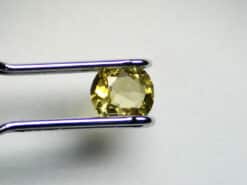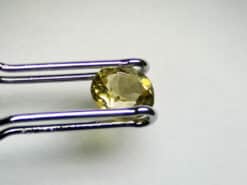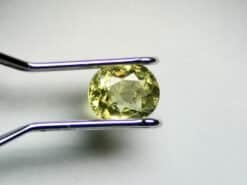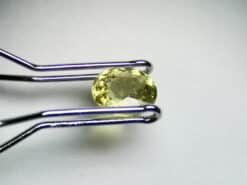Chrysoberyl
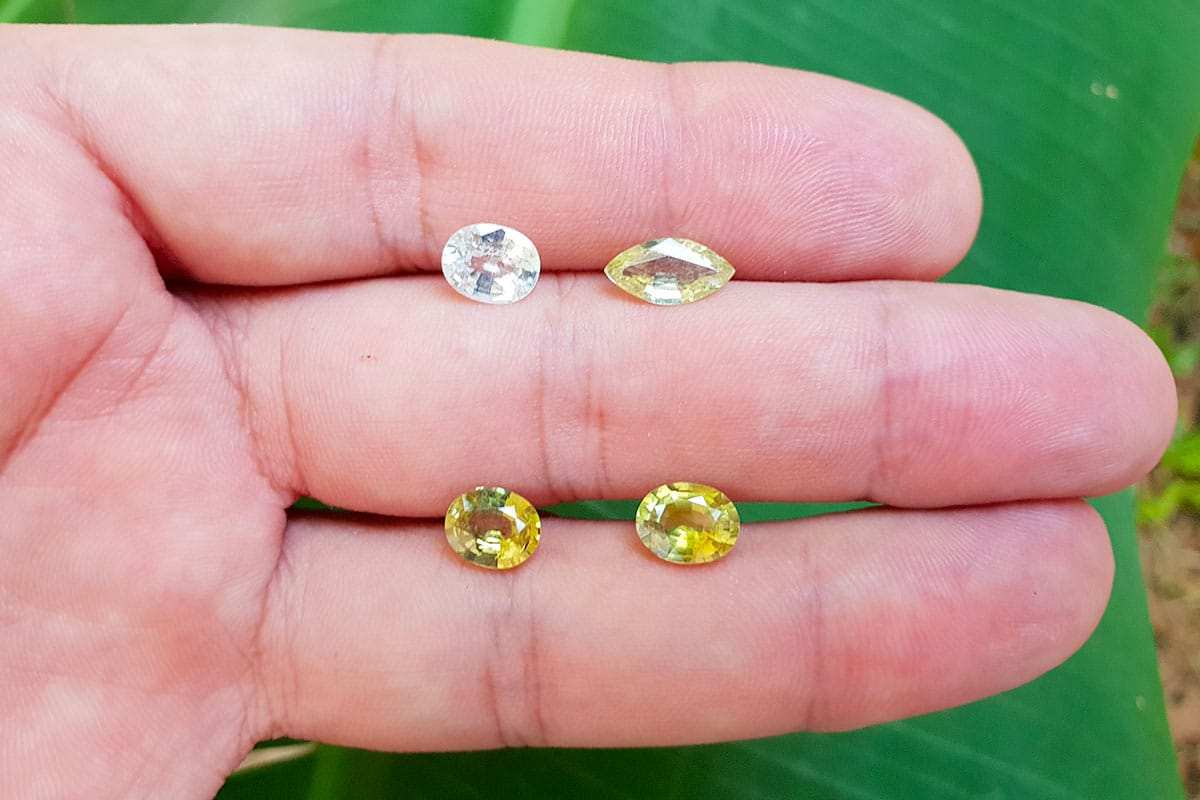
The mineral chrysoberyl is an aluminate of beryllium with the chemical formula BeAl2O4. Although it shares part of its name with the mineral beryl, these two gemstones are distinctly different in composition, crystal structure, and appearance.
Buy natural chrysoberyl in our shop
Chrysoberyl stone
The name “chrysoberyl” derives from the Greek words chrysos (meaning “gold”) and beryllos (“beryl-like”), reflecting its typical golden-green hue. Despite the similarity in nomenclature, chrysoberyl and beryl differ significantly as gemstones, even though both contain beryllium. Chrysoberyl is notably hard, ranking at 8.5 on the Mohs scale, making it the third-hardest commonly encountered natural gemstone after diamond and corundum.
When chrysoberyl displays a pale green to yellow hue and excellent transparency, it can be considered a high-quality gemstone. There are three main varieties: the ordinary yellow-to-green chrysoberyl, the remarkable cat’s eye chrysoberyl (also known as cymophane), and the color-changing alexandrite variety.
During the Victorian and Edwardian eras, yellow-green chrysoberyl was sometimes referred to as “chrysolite,” a term that also historically applied to the mineral peridot. Due to confusion in gemological nomenclature, the name “chrysolite” is no longer used for chrysoberyl.
Pegmatitic processes
Chrysoberyl typically forms as a result of pegmatitic processes. When molten magma rises within the Earth’s crust, it gradually cools. As it does so, the concentration of water and other volatile components in the melt increases. Over time, these residual fluids become enriched in rare elements that are not easily incorporated into the common rock-forming minerals.
As the magma body cools further, it becomes saturated with water and rare elements. This allows specialized minerals, including chrysoberyl, to crystallize. The unique conditions of pegmatites—especially their high water content—enable crystals to grow quickly and often to large sizes, increasing the likelihood of forming gemstone-quality crystals.
Igneous in appearance
The rock in which chrysoberyl forms often has an igneous appearance, yet it is influenced by water-rich conditions during crystallization. This environment leads to large crystals of common minerals, such as quartz and feldspar, as well as concentrations of more unusual elements like beryllium. These elements may form rare minerals, including chrysoberyl.
Pegmatites are known for producing large crystals due to the abundance of fluids in the melt, which help elements diffuse rapidly and form well-developed crystal structures. This ideal environment makes pegmatites prime sources for gem chrysoberyl.
In mica schists
Chrysoberyl can also appear in metamorphic rocks, such as mica schists, formed when pegmatite-derived fluids rich in beryllium and aluminum react with the surrounding country rock. In some cases, these conditions can also occur in contact metamorphic deposits of dolomitic marble, where chrysoberyl may crystallize in response to local geochemical environments.
Due to its notable hardness and resistance to chemical alteration, chrysoberyl can survive weathering processes. Over time, it may be transported by streams and rivers, eventually concentrating in alluvial deposits. In these secondary environments, chrysoberyl grains are often found rounded and worn, mixed with other durable gem minerals.
Alluvial deposits that yield chrysoberyl may also contain other resistant gemstones such as diamond, corundum, topaz, spinel, garnet, and tourmaline. However, unlike other minerals, chrysoberyl’s wedge-shaped crystals, when found as weathered fragments, tend to exhibit smooth, rounded edges.
Chrysoberyl crystal rich in beryllium
If the pegmatitic fluid is especially rich in beryllium, minerals such as beryl or chrysoberyl can form. While beryl has a higher ratio of beryllium to aluminum, chrysoberyl is comparatively richer in aluminum. Both of these beryllium-bearing minerals remain stable in association with quartz, but their formation conditions vary, giving rise to distinct species.
For the rare alexandrite variety to grow, the presence of chromium is essential. Yet, chromium is typically concentrated in mafic and ultramafic rocks, where beryllium is scarce. Conversely, beryllium tends to accumulate in more felsic, silica-rich pegmatites, where chromium is nearly absent. Thus, alexandrite’s formation requires a rare geological coincidence where chromium-bearing rocks interact with beryllium-rich fluids. This unique set of circumstances explains alexandrite’s rarity.
Chrysoberyl meaning and healing properties
In various metaphysical traditions, chrysoberyl is believed to convert negative thoughts into positive energy, boosting self-confidence and enhancing self-worth. It is thought to align the solar plexus and crown chakras, opening the crown chakra and amplifying both spiritual and personal power. Chrysoberyl has been associated with prosperity, creativity, and the promotion of generosity and compassion.
Chrysoberyl gemstone from Africa
Historical and cultural significance of chrysoberyl
Throughout history, chrysoberyl’s captivating colors and distinctive optical effects have garnered the appreciation of gem enthusiasts and collectors. Although it never achieved the widespread fame of certain other gems, chrysoberyl was valued by ancient cultures and later gained recognition in the 19th century, particularly after the discovery of alexandrite. Royalty and aristocrats admired chrysoberyl for its durability and unique appearance, and today, dedicated collectors continue to treasure it for its rarity and allure.
Optical properties and identifying features
Chrysoberyl often displays a brilliant vitreous luster and excellent transparency. Some specimens show pleochroism, changing color when viewed from different angles. The cat’s eye variety (cymophane) exhibits a sharp band of light caused by microscopic inclusions, creating a phenomenon known as chatoyancy. This effect is highly prized and best seen in cabochon-cut stones, where the “eye” appears centered and distinct.
Sources and geographic distribution
Notable chrysoberyl sources include Brazil, Sri Lanka, Russia (historically significant for alexandrite), parts of Africa, Southeast Asia, and certain localities in the United States. Each source may yield stones with subtle differences in hue, clarity, and crystal habit, providing a fascinating range of material for gem enthusiasts and collectors worldwide.
Cutting and shaping chrysoberyl
Gem cutters often facet chrysoberyl to enhance its natural brilliance and clarity. Its hardness allows for crisp facet edges and excellent polish. For cat’s eye chrysoberyl, a cabochon cut is preferred to highlight the distinctive “eye” effect. Skilled lapidaries carefully orient and shape each stone to maximize its color, optical phenomena, and overall aesthetic appeal.
Durability and care
With a hardness of 8.5 on the Mohs scale, chrysoberyl is durable enough for regular wear. It resists scratches from most materials encountered daily. Simple maintenance includes cleaning with warm, soapy water and a soft brush. Avoid harsh chemicals and extreme temperature changes. Proper storage away from harder gemstones helps preserve its pristine condition.
Chrysoberyl in contemporary jewelry design
Chrysoberyl’s distinctive colors and phenomena have made it a sought-after choice for unique jewelry pieces. Contemporary designers value its versatility and strength, incorporating it into rings, pendants, and earrings. Whether set alone or combined with other gemstones, chrysoberyl can create timeless pieces that appeal to both classic and modern tastes.
Collecting and valuing chrysoberyl
Collectors appreciate chrysoberyl for its rarity, beauty, and optical effects. Its value depends on factors like color saturation, clarity, cut quality, and the presence of special phenomena such as the cat’s eye effect or color change in alexandrite. Fine-quality specimens, especially those in larger sizes, command premium prices in the market.
Scientific interest in chrysoberyl
Beyond its aesthetic allure, chrysoberyl is of scientific interest to mineralogists studying the conditions under which rare minerals form. Its presence provides insights into the geochemical processes at play in pegmatites and metamorphic environments. By examining chrysoberyl’s formation, scientists gain a deeper understanding of fluid composition, temperature, and pressure conditions within the Earth’s crust.
FAQ
What is chrysoberyl made of?
Chrysoberyl is an aluminate of beryllium with the chemical formula BeAl2O4. It is a distinct mineral species, different from beryl, despite the similarity in their names.
How hard is chrysoberyl?
Chrysoberyl ranks 8.5 on the Mohs hardness scale, making it the third-hardest commonly encountered natural gemstone after diamond (10) and corundum (9).
What is cat’s eye chrysoberyl?
Cat’s eye chrysoberyl, also known as cymophane, displays a chatoyant “eye” effect caused by parallel inclusions. When cut as a cabochon, a bright, narrow line of light appears, resembling a cat’s eye.
How does alexandrite differ from other chrysoberyl varieties?
Alexandrite is a rare variety of chrysoberyl that exhibits a color change from green in daylight to reddish-purple under incandescent light. This unique phenomenon is due to the presence of chromium in its crystal structure.
Where is chrysoberyl found?
Chrysoberyl is found in pegmatites, metamorphic rocks, and alluvial deposits worldwide. Significant sources include Brazil, Sri Lanka, parts of Africa, Russia, and Southeast Asia.
Is chrysoberyl suitable for everyday jewelry?
Yes, chrysoberyl’s high hardness and durability make it well-suited for everyday wear, provided it is properly cared for and protected from harsh chemicals or extreme temperatures.
Does chrysoberyl have any symbolic or healing properties?
In various metaphysical traditions, chrysoberyl is believed to promote self-confidence, creativity, and generosity. It is associated with the solar plexus and crown chakras, enhancing spiritual and personal power.
How should chrysoberyl be cleaned?
Warm, soapy water and a soft brush are generally sufficient for cleaning chrysoberyl. Avoid harsh chemicals, high heat, or ultrasonic cleaners that may damage the stone or its setting.
What factors affect chrysoberyl’s value?
Color, clarity, cut, and phenomena (such as the cat’s eye effect or color change in alexandrite) are key factors that determine chrysoberyl’s value. High-quality stones with intense hues and minimal inclusions command higher prices.
Can chrysoberyl help identify geological conditions?
Yes. The presence of chrysoberyl in certain geological environments can provide clues about temperature, pressure, and the chemical composition of fluids during rock formation, helping mineralogists understand Earth’s internal processes.

